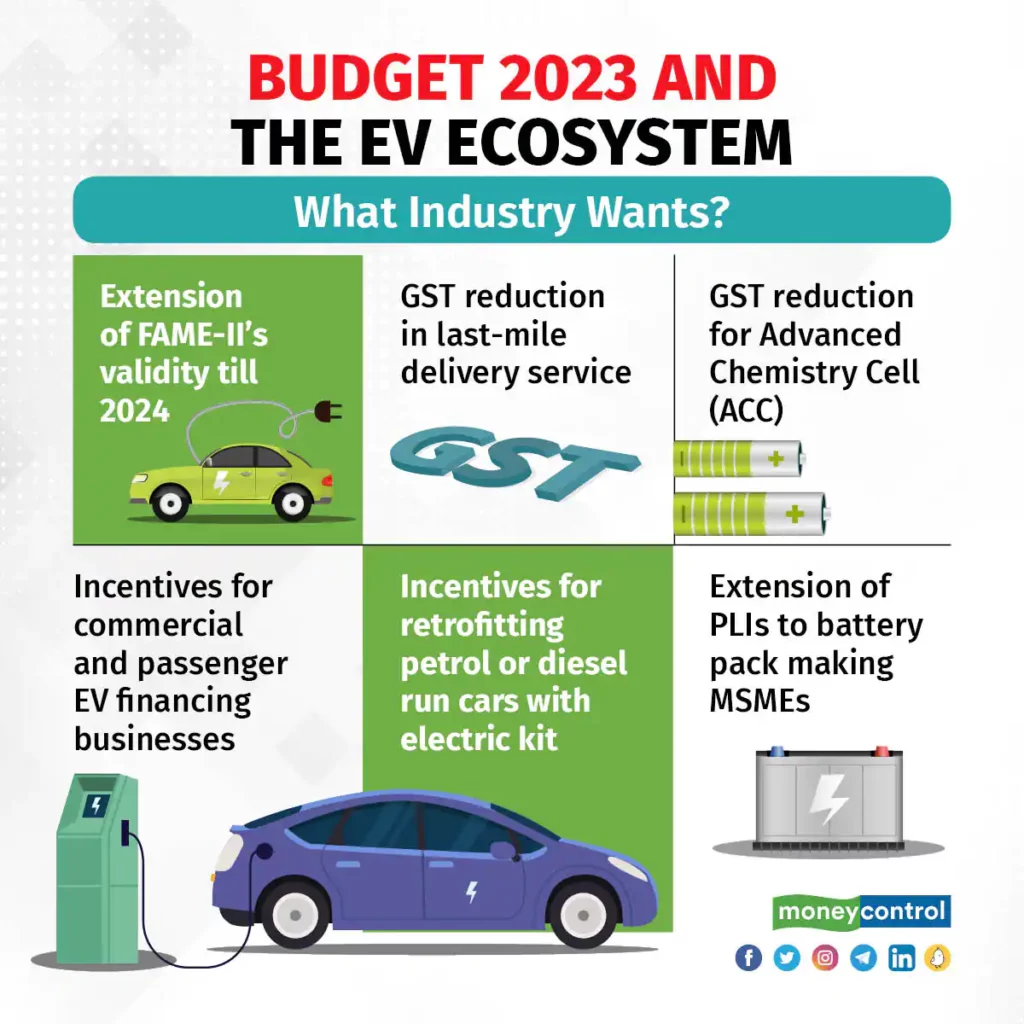Published On January 28, 2023
Budget 2023: EV Industry's Expectations from Finance Minister Nirmala Sitharaman
India’s growing electric vehicle (EV) industry is looking forward to the Budget 2023 which will be presented by Union Finance Minister Nirmala Sitharaman on 1 February 2023.
The EV sector (including ancillaries) are looking forward to a slew of sops, including the extension of the Faster Adoption and Manufacturing of Hybrid and Electric Vehicles (FAME-II) scheme beyond 2024, and a reduction of GST.
“The EV industry expects the GST on ACC (Advanced Chemistry Cell) batteries to be reduced and brought on par with EVs (5 percent),” said Chetan Maini, Co-Founder and Chairman, SUN Mobility.
Bengaluru-based SUN Mobility recently announced that it plans to sell more than 10,000 electric two-wheelers (E2W) in India by 2023.
Electric two-wheeler (E2W) adoption is growing at a fast pace, and India is poised to be one of the world’s largest two-wheeler markets. In November 2022, a total of 18,47,208 two-wheelers were retailed across India, 76,438 of which (4.1 percent) were E2Ws.
To further grow that, Zypp Electric believes that the GST for last-mile delivery services needs to be reduced.
“My biggest pain point right now is that the use of EVs is picking up in the last-mile delivery segment — like Zomato, Bigbasket, Amazon, etc. — but we have a GST of 18 percent with no incentives,” Said Akash Gupta, Co-Founder, and CEO, Zypp.
“I can make the entire last-mile delivery industry go electric in the next two years. But we are finding it difficult to scale up. We expect the GST to be brought down to zero in the coming budget,” he added.
The budget for 2022-23 focussed on promoting electric vehicles. To boost demand, financial incentives of Rs 10,000 crore were provided under FAME-II. To support supplies, PLI (production-linked incentive) schemes totaling Rs 44,038 crore had been announced, including for ACC batteries.
Commercial EV adoption
India needs to work on developing the commercial EV segment as well, said Inderveer Singh, Founder, and CEO, of EVage, a commercial EV manufacturer in India.
“The government needs to consider commercial EV financing to enable quick adoption in the E4W category. Instead of subsidies, we need lower interest rates for EV financing and standardized residual battery value calculation (what is this & how does it impact the industry). Fleet owners will significantly benefit from the clearance of these hurdles,” Singh added.
BUDGET 2023-24: Catch all the updates here
The current size of the electric LCV market stands at about 3,50,000- 400,000 units and is expected to grow at 7-10 percent per annum till 2025. This segment is primarily driven by e-commerce and logistics players who are electrifying their first and last-mile fleets to reduce costs as also to meet ESG requirements.
Speaking to the media, Bhavish Aggarwal, Founder, of Ola Electric, said that in 2023 the company would focus on making motorbikes, rolling out lithium-ion cells, and entering the commercial vehicle (CV) space.
“Our investment focus for 2023 will be on light commercial vehicles (LCV) and motorcycles, as well as lithium-ion cells,” he had said.
“Most state EV policies do not include four-wheelers or fast-charging infrastructure guidelines. There needs to be a swift change in this in 2023 to galvanize the commercial EV sector,’’ Singh added.

Extension of FAME-II
EV manufacturers of India also expect the government to adopt a long-term outlook and extend the validity of the scheme beyond 2024.
“Such policy stability will eventually boost EV adoption in the country,” said Sachidanand Upadhyay, MD and CEO, of Lord’s Mark Industries, a firm that deals in EV infra.
He said that the industry expected the budget to incentivize retrofitting petrol and diesel-run cars with electric kits to accelerate EV adoption.
“In addition, there is an urgent need to build awareness about the vehicle scrappage policy to encourage the phasing out of end-of-life vehicles and drive EV sales,” Upadhyay added.
Per EVage data, the share of EVs among total new cars sold breached the 3 percent mark for the first time in November and in 2023 that figure could be more than 5 percent. Globally, there is evidence that the sales of EVs skyrocket after crossing the 5 percent threshold.
Support for MSME
“The government needs to ensure a level playing field for MSME players in the EV sector for inclusive growth,” Upadhyay added.
Maini said the PLI scheme should be extended to MSMEs that manufacture/assemble ACs, battery packs, and charging and battery-swapping equipment.
Speaking about investment in EVs, Singhvi said that more subsidies were required to support EV financing.
“There are state-wise differences in sops and that needs to change. NBFCs should be incentivized to fund EVs, only then will growth take place,” Singhvi added.
